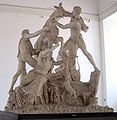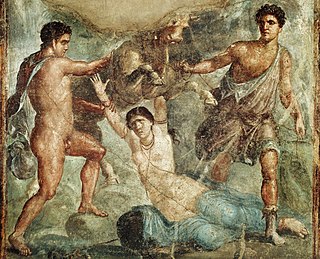
Dirce was a queen of Thebes as the wife of Lycus in Greek mythology.

Palazzo Farnese or Farnese Palace is one of the most important High Renaissance palaces in Rome. Owned by the Italian Republic, it was given to the French government in 1936 for a period of 99 years, and currently serves as the French embassy in Italy.

In ancient Rome, thermae and balneae were facilities for bathing. Thermae usually refers to the large imperial bath complexes, while balneae were smaller-scale facilities, public or private, that existed in great numbers throughout Rome.
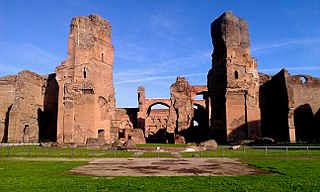
The Baths of Caracalla in Rome, Italy, were the city's second largest Roman public baths, or thermae, after the Baths of Diocletian. The baths were likely built between AD 212 and 216/217, during the reigns of emperors Septimius Severus and Caracalla. They were in operation until the 530s and then fell into disuse and ruin.

The Farnese Hercules is an ancient statue of Hercules, probably an enlarged copy made in the early third century AD and signed by Glykon, who is otherwise unknown; he was an Athenian but he may have worked in Rome. Like many other Ancient Roman sculptures it is a copy or version of a much older Greek original that was well known, in this case a bronze by Lysippos that would have been made in the fourth century BC. This original survived for over 1500 years until it was melted down by Crusaders in 1205 during the Sack of Constantinople. The enlarged copy was made for the Baths of Caracalla in Rome, where the statue was recovered in 1546, and is now in the Museo Archeologico Nazionale in Naples. The heroically-scaled Hercules is one of the most famous sculptures of antiquity, and has fixed the image of the mythic hero in the European imagination.

Lysippos was a Greek sculptor of the 4th century BC. Together with Scopas and Praxiteles, he is considered one of the three greatest sculptors of the Classical Greek era, bringing transition into the Hellenistic period. Problems confront the study of Lysippos because of the difficulty of identifying his style among the copies which survive. Not only did he have a large workshop and many disciples in his immediate circle, but there is understood to have been a market for replicas of his work, supplied from outside his circle, both in his lifetime and later in the Hellenistic and Roman periods. The Victorious Youth or Getty bronze, which resurfaced around 1972, has been associated with him.

The Farnese Atlas is a 2nd-century AD Roman marble sculpture of Atlas holding up a celestial globe. Probably a copy of an earlier work of the Hellenistic period, it is the oldest extant statue of Atlas, a Titan of Greek mythology who is represented in earlier Greek vase painting, and the oldest known representation of the celestial sphere and the classical constellations. The sculpture is at the National Archaeological Museum of Naples, in Italy.

The National Archaeological Museum of Naples is an important Italian archaeological museum, particularly for ancient Roman remains. Its collection includes works from Greek, Roman and Renaissance times, and especially Roman artifacts from the nearby Pompeii, Stabiae and Herculaneum sites. From 1816 to 1861, it was known as Real Museo Borbonico.
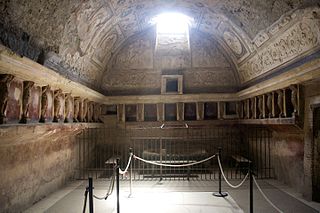
The tepidarium was the warm (tepidus) bathroom of the Roman baths heated by a hypocaust or underfloor heating system. The speciality of a tepidarium is the pleasant feeling of constant radiant heat, which directly affects the human body from the walls and floor.

Museo di Capodimonte is an art museum located in the Palace of Capodimonte, a grand Bourbon palazzo in Naples, Italy designed by Giovanni Antonio Medrano. The museum is the prime repository of Neapolitan painting and decorative art, with several important works from other Italian schools of painting, and some important ancient Roman sculptures. It is one of the largest museums in Italy. The museum was inaugurated in 1957.

The study of Roman sculpture is complicated by its relation to Greek sculpture. Many examples of even the most famous Greek sculptures, such as the Apollo Belvedere and Barberini Faun, are known only from Roman Imperial or Hellenistic "copies". At one time, this imitation was taken by art historians as indicating a narrowness of the Roman artistic imagination, but, in the late 20th century, Roman art began to be reevaluated on its own terms: some impressions of the nature of Greek sculpture may in fact be based on Roman artistry.

Posillipo is an affluent residential quarter of Naples, southern Italy, located along the northern coast of the Gulf of Naples.

The National Roman Museum is a museum, with several branches in separate buildings throughout the city of Rome, Italy. It shows exhibits from the pre- and early history of Rome, with a focus on archaeological findings from the period of Ancient Rome.

The Crouching Venus is a Hellenistic model of Venus surprised at her bath. Venus crouches with her right knee close to the ground, turns her head to the right and, in most versions, reaches her right arm over to her left shoulder to cover her breasts. To judge by the number of copies that have been excavated on Roman sites in Italy and France, this variant on Venus seems to have been popular.

The Antinous Farnese is a marble sculptural representation of Antinous that was sculpted between 130 and 137 CE. Antinous was the lover to Roman Emperor Hadrian; the emperor who, after Antinous's death, perpetuated the image of Antinous as a Roman god within the Roman empire. This sculpture is a part of the Roman Imperial style and was sculpted during a revival of Greek culture, initiated by Hadrian's philhellenism. Its found spot and provenance are unknown, but this sculpture is currently a part of the Farnese Collection in the Naples National Archaeological Museum.
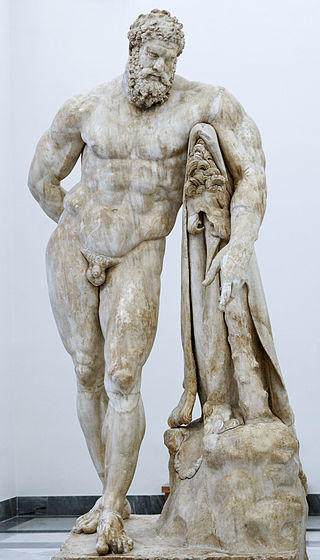
The classical sculptures in the Farnese Collection, one aspect of this large art collection, are one of the first collections of artistic items from Greco-Roman antiquity. It includes some of the most influential classical works, including the sculptures that were part of the Farnese Marbles, their collection of statuary, which includes world-famous works like the Farnese Hercules, Farnese Cup, Farnese Bull and the Farnese Atlas. These statues are now displayed in the Naples National Archaeological Museum in Italy with some in the British Museum in London.

The Venus Callipyge, also known as the Aphrodite Kallipygos or the Callipygian Venus, all literally meaning "Venus of the beautiful buttocks", is an Ancient Roman marble statue, thought to be a copy of an older Greek original. In an example of anasyrma, it depicts a partially draped woman, raising her light peplos to uncover her hips and buttocks, and looking back and down over her shoulder, perhaps to evaluate them. The subject is conventionally identified as Venus (Aphrodite), though it may equally be a portrait of a mortal woman.

Piazza Farnese is the main square of the Regola district of Rome, Italy.

The Palazzo Massimo alle Terme is the main of the four sites of the Roman National Museum, along with the original site of the Baths of Diocletian, which currently houses the epigraphic and protohistoric section, Palazzo Altemps, home to the Renaissance collections of ancient sculpture, and the Crypta Balbi, home to the early medieval collection.





